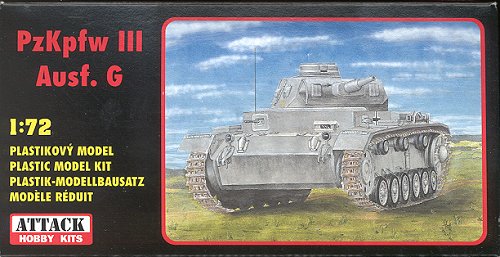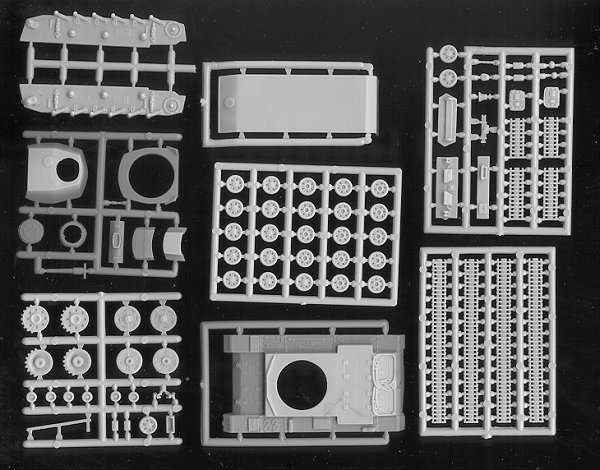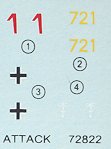
|
KIT: |
Attack Hobbies 1/72 PzKw III ausf G |
|
KIT # |
72822 |
|
PRICE: |
$18.98 ($16.97 at Squadron) |
|
DECALS: |
two options |
|
REVIEWER: |
Scott Van Aken |
|
NOTES: |
Includes etched brass fret |

|
HISTORY |
Panzer III entered for the first time action, and small amounts, during the invasion of Poland. Then it mounted a barrel of 3,7 cm Kw.K. L/45, that would be changed by one of 5,0 cm Kw.K. L/42 in the most modern models. The Pz.Kpfw.III formed the main thickness of the Panzerdivisionen in the first years of the war, and was produced until in 12 different versions without counting Stug III that they had the same chassis.
The first version of the Pz.Kpfw.III was the Ausf.A (Sd.Kfz.141), constructed by Daimler-Benz in 1936, and armed with a barrel of 3,7 cm Kw.K L/45 and three MG34, two in the turret next to the barrel and another one in the chassis. The turret was constructed the sufficiently ample thing to allow the installation of a barrel of greater caliber in the future.
The motor that it had was a Maybach HL108 TR of 12 cylinders and 250 horses with which Km/h reached 35 a terminal velocity of, and the suspension was formed by five wheels. This tank had a weight of 15 tn, and armor of 14,5 mm in the front and the sides. The crew was formed by five men which allowed to distribute to the work reducing therefore the fatigue of the combat. Altogether 10 were constructed Pz.Kpfw.III Ausf.A in 1936.
To the Ausf.B versions, Cs and D added to small modifications, emphasizing the increase to them in eight smaller wheels in the suspension. 15 took place Ausf.B in 1937, 15 Ausf.C and 55 Ausf.D in 1938. Some of them entered into combat during the invasion of Poland.
The Ausf.E was the first model of series production and acceptable number. A motor more powerful Maybach HL120 TR of 12 cylinders and 300 cv was put to him that would be the standard of the future, and increased therefore the speed up to 40 Km/h.
The number of wheels was reduced definitively and for all the following models to six in the suspension, that would be the definitive standard. Also the armor was increased to him up to 30 mm which produced an increase of weight that was fixed to 19,5 tons. Of the 98 Pz.Kpfw.III which the majority acted in Poland was Ausf.E. 100 took place about Ausf.E in 1939.
In the Ausf.F small changes in the turret were added (that received an additional structure in the part of back). From this model only two MG34 would be gotten up, one in the turret and another one in the chassis.
The Ausf.F along with the Ausf.E in smaller amount was the used models of Pz.Kpfw.III during the campaign of France in 1940. Later, to the last models of the Ausf. F (about 100) mounted a barrel to them of 5,0 cm kwk L/42 replacing therefore the one of 3,7 cm. Altogether 435 took place Pz.Kpfw.III Ausf.F in 1940.
To the Ausf.G the cupola of the commander changed to him and all were exclusively constructed with the barrel of 5,0 cm Kw.K L/42. A few Pz.Kpfw.III Ausf. G was used by D.A.K. ( Deutsche Afrika Korps ) during the first offensive of Rommel in April of 1941. 600 entered about Ausf.G 1941 in good condition.
Thanks to an unknown Spanish tank site (found via Google.com) for the above history.
|
THE KIT |

As you can see from the image, you get a lot of parts on
8 grey sprues. The overall detailing is fairly good, though a touch on
the soft side. Raised or engraved panel lines have no meaning with armor!
There is no flash, no sink areas that will be seen in the final
construction and the only possibly visible ejector pin marks are on the
outside of the suspension pieces on the upper left of the image. These
will be easy to remove and may well be hidden by the road and idler
wheels. Tracks are in sections and for those sections that need to wrap
around an idler wheel, the builder simply bends the section with a pair
of scissors as a guide (the instructions show how this is done). You'll
notice that the sprockets only have teeth on one side so no need to worry
about threading teeth through the links. You have the option to open the
holes in the sprockets should you desire. There is no interior to worry
about and the only part you have to scratch build is the antenna wire! No painting info is provided in the construction steps.
No painting info is provided in the construction steps.
The instructions are a single sheet of paper folded over. No history is provided. The construction drawings are more than adequate to build the kit. Painting info is provided only for the exterior and color info is given by name as well as Humbrol, Tamiya, and Agama numbers. You have your choice of two overall colors; Panzer Grey or Desert yellow as one of the decal options is Russia in 1941 and the other is Afrika Corps in 1942. There is a very small decal sheet provided. It looks to be well printed but it may also be a bit transparent as the white Afrika Corps insignia is difficult to see on the light blue background.
|
CONCLUSIONS |
I'm thinking that this must be a variant that has not yet been kitted in this scale otherwise why the effort to do one? It looks as if it will be relatively simple to build and the end result will be a model of an interesting and important tank. Since it doesn't have a ton of teeny pieces, it may not be a bad kit for someone just getting into small scale armor to build.
If you would like your product reviewed fairly and quickly by a site that has over 200,000 visitors a month, please contact me or see other details in the Note to Contributors.